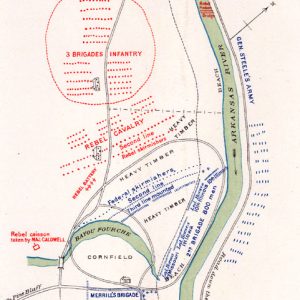calsfoundation@cals.org
Engagement at Bayou Fourche
aka: Battle of Little Rock
| Location: | Pulaski County |
| Campaign: | Advance on Little Rock (1863) |
| Date(s): | September 10, 1863 |
| Principal Commanders: | Brigadier General John W. Davidson (US); Brigadier General John S. Marmaduke (CS) |
| Forces Engaged: | Cavalry Division, Army of Arkansas, Arkansas Expedition (US); District of Arkansas (CS) |
| Estimated Casualties: | 72 (US); unknown (CS) |
| Result: | Union victory |
The Engagement at Bayou Fourche, also known as the Battle of Little Rock, was a Civil War battle fought on September 10, 1863, as Confederate troops sought to stop Major General Frederick Steele’s Union army from capturing Little Rock (Pulaski County).
Steele had advanced steadily across eastern Arkansas during August with a combined force of infantry from Helena (Phillips County) and cavalry that had come down Crowley’s Ridge from Missouri. With the exception of the short Action at Bayou Meto (or Reed’s Bridge) on August 27, the Union approach to Little Rock had seen relatively light resistance. As the Union army prepared for its final assault on the Arkansas capital, Steele had some 10,477 men present for duty and fifty-seven cannon. Confederate commander Major General Sterling Price commanded 7,749 men, most holding the fortifications at present-day North Little Rock (Pulaski County) while a thin screen of Confederate horsemen sought to defend a dozen fordable sites along the Arkansas River.
On the evening of September 9, Union engineers began building a pontoon bridge across the Arkansas River at Terry’s Ferry, located at a horseshoe bend downriver from Little Rock. This position enabled Union troops to place converging artillery fire on Confederate defenders of the southern bank. Steele also sent a diversionary force east to threaten Buck’s Ford on the Arkansas River.
Around daylight on September 10, Confederate artillery fired on the bridge but was quickly silenced by Union cannon fire. At about 10:00 a.m., two regiments of Union infantry rushed across the bridge and established a beachhead. Two brigades of Union cavalry followed, while the Union infantry headed west along the north bank of the Arkansas River to face the strong Confederate fortifications on high ground at present-day North Little Rock.
Confederate colonel Archibald Dobbins and his men fell back steadily under pressure from the Union First Brigade under Colonel Lewis Merrill and the Second Brigade under Colonel J. M. Glover. Dobbins ordered about 500 troops to form along Bayou Fourche, also calling in the men facing the Union feint at Buck’s Ford. Dobbins’s troops consisted of Arkansas, Missouri, Louisiana, and Texas cavalry and two artillery batteries, later bolstered by Confederate infantry. Brigadier General John S. Marmaduke replaced Dobbins as the Confederate commander during the battle.
The Engagement at of Bayou Fourche, which took place near the present-day Little Rock National Airport, was essentially two fights, with Glover’s First Brigade moving through a heavily wooded area between the bayou and the Arkansas River, while Merrill’s troops advanced through a large cornfield south of the bayou. Marmaduke formed his lines behind a levee on the west side of the bayou.
Glover’s command—consisting of the First Iowa Cavalry, the Tenth Illinois Cavalry, the Third Missouri Cavalry (US), and elements of the Second Missouri Light Artillery—faced part of Marmaduke’s division led by Colonel William L. Jeffers, which was composed of the Eighth Missouri Cavalry (CS), Greene’s Regiment, Burbridge’s Regiment, and Young’s Battalion. The Union cavalry began a mounted advance, but after losing an artillery battery to Confederate cavalry, Glover commanded his troops to dismount and move forward on foot. The dismounted men steadily drove back Jeffers’s troops.
Merrill, meanwhile, led the Eighth Missouri Cavalry (US) and the Second Missouri Cavalry (US), supported by the Twenty-fifth Ohio Battery, through the cornfield under artillery fire from Marmaduke’s men. As Confederate infantry arrived on the field to support the harried cavalry, Union artillery from the north bank of the river began firing on the Confederate troops’ flanks, preventing them from making an effective counterattack. Glover’s troops broke out of the timber on the north side of the battlefield, leading the Confederate forces to fall back toward Little Rock with Union cavalry following close behind.
When Price realized the Union cavalry was flanking his main defensive line north of the river, he ordered his infantry south, across the Arkansas River, burned his pontoon bridge, and began evacuating Little Rock and retreating toward southwest Arkansas. A final Rebel defensive line was set up on the fairgrounds on Little Rock’s southern boundary, but the Union forces did not challenge them, contenting themselves to accept the surrender of Arkansas’s capital city from Little Rock’s civil authorities.
The Engagement at Fourche Bayou resulted in seventy-two Union casualties; Confederate losses were not reported.
For additional information:
Burford, Timothy Wayne, and Stephanie Gail McBride. The Division: Defending Little Rock, August 25th–September 10th, 1863. Jacksonville, AR: WireStorm Publishing, 2000.
Christ, Mark K. Civil War Arkansas, 1863: The Battle for a State. Norman: University of Oklahoma Press, 2010.
———. “The Earth Reeled and Trees Trembled”: Civil War Arkansas, 1863–1864. Little Rock: Old State House Museum, 2007.
———. “Here in the Wilds of Arkansas: Interpreting the Little Rock Campaign.” MLS thesis, University of Oklahoma, 2000.
Huff, Leo. “The Union Expedition Against Little Rock.” Arkansas Historical Quarterly 22 (Autumn 1963): 222–237.
Mark K. Christ
Arkansas Historic Preservation Program
 Bayou Fourche
Bayou Fourche  Bayou Fourche Commemorative Marker
Bayou Fourche Commemorative Marker  Civil War Events Map
Civil War Events Map  John Davidson
John Davidson  Marker Grounds
Marker Grounds  John Marmaduke
John Marmaduke 



Comments
No comments on this entry yet.